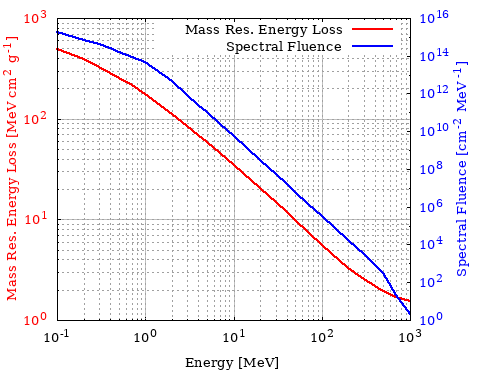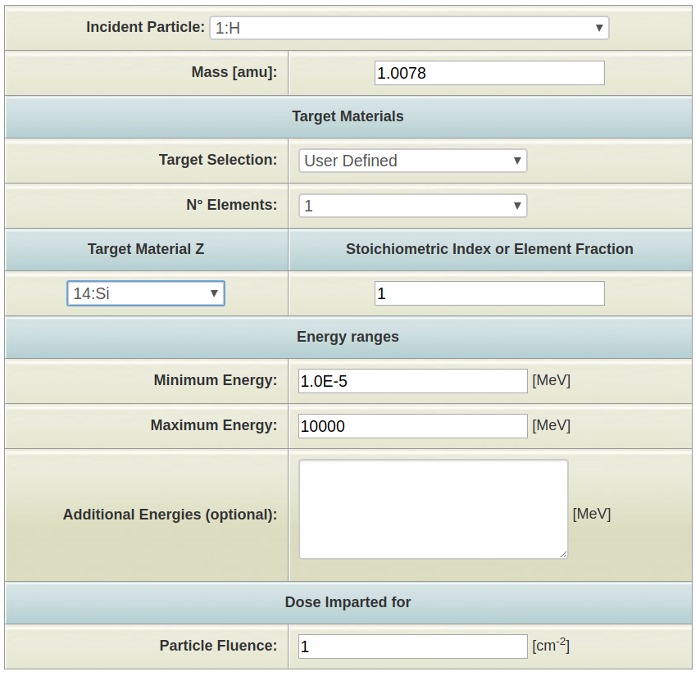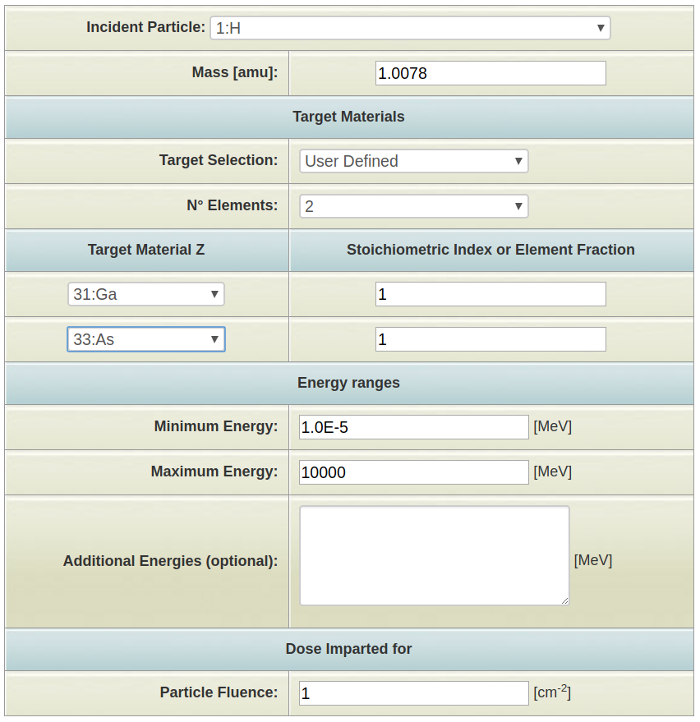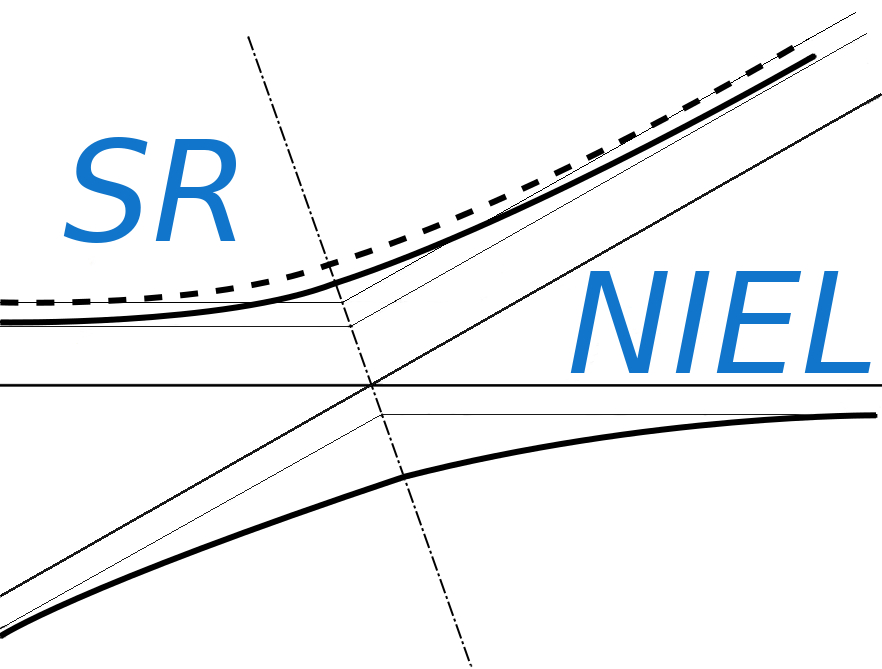The current web calculator regards the restricted energy loss implemented within SR-Framework (see Restricted energy-loss treatment within SR-NIEL framework).
EXAMPLE:
Copy and paste the data here to reproduce the following example.
Mass restricted energy loss with W0=100 keV (red) in Silicon and protons spectral fluence (blue) assuming an orbit around Jupiter, at Europa altitude, during 1 year mission:
 Spectral fluence data are calculated with JOREM Model implemented in SPENVIS assuming a 4π solid angle exposure.
To be remarked about W0
To a first approximation, W0 can be estimated from the electron energies whose corresponding total ranges allow electrons to be fully absorbed inside the medium, i.e., such energies cannot exceed that corresponding to the maximum pathlength inside the device. For electron energies where the radiation energy-loss is not a significant part of the energy-loss process, the practical ranges of electrons in units of g/cm2 are almost independent of the atomic mass-number of traversed absorber (e.g., see Equation (1-21) in Section 1-10 of [Price (1964)] and discussion in Sect. 2.3.2 of [Leroy and Rancoita (2016)]). An example of practical range in g/cm2 of electrons is shown in Figure 9 in this webpage). The curve is obtained using Eq. (2.134) in Sect. 2.3.2 of [Leroy and Rancoita (2016)] (see also, Eq. (1-18) in Sect. 1-10 of [Price (1964)]). Furthermore, values of the CSDA ranges of electrons in materials can be obtained from ESTAR database at NIST. Practical ranges and CSDA ranges of electrons may be employed to roughly estimate the values of W0 for microelectronic devices or semiconductor detectors.
The indicated default-value of 100 keV for W0 approximately corresponds to a practical range (see webpage) of about 0.0135 g cm-2 for electrons in an absorber or in a device active-depth directly exposed to the incoming particles flux. For a correct usage of the present web calculator, the inserted value of W0 should appropriately account for absorber thickness (or device active-depth) and enviromental conditions.
NOTE:
Output table and graph include the restricted energy loss in units of Mev cm2/g (i.e., the mass restricted energy loss).
The lower energy limit is 1 eV
W0 is set to be larger than five times the mean excitation energy of the absorber.
Target selection for the results obtained in the EXAMPLE section
Selection for Protons in Silicon:
Spectral fluence data are calculated with JOREM Model implemented in SPENVIS assuming a 4π solid angle exposure.
To be remarked about W0
To a first approximation, W0 can be estimated from the electron energies whose corresponding total ranges allow electrons to be fully absorbed inside the medium, i.e., such energies cannot exceed that corresponding to the maximum pathlength inside the device. For electron energies where the radiation energy-loss is not a significant part of the energy-loss process, the practical ranges of electrons in units of g/cm2 are almost independent of the atomic mass-number of traversed absorber (e.g., see Equation (1-21) in Section 1-10 of [Price (1964)] and discussion in Sect. 2.3.2 of [Leroy and Rancoita (2016)]). An example of practical range in g/cm2 of electrons is shown in Figure 9 in this webpage). The curve is obtained using Eq. (2.134) in Sect. 2.3.2 of [Leroy and Rancoita (2016)] (see also, Eq. (1-18) in Sect. 1-10 of [Price (1964)]). Furthermore, values of the CSDA ranges of electrons in materials can be obtained from ESTAR database at NIST. Practical ranges and CSDA ranges of electrons may be employed to roughly estimate the values of W0 for microelectronic devices or semiconductor detectors.
The indicated default-value of 100 keV for W0 approximately corresponds to a practical range (see webpage) of about 0.0135 g cm-2 for electrons in an absorber or in a device active-depth directly exposed to the incoming particles flux. For a correct usage of the present web calculator, the inserted value of W0 should appropriately account for absorber thickness (or device active-depth) and enviromental conditions.
NOTE:
Output table and graph include the restricted energy loss in units of Mev cm2/g (i.e., the mass restricted energy loss).
The lower energy limit is 1 eV
W0 is set to be larger than five times the mean excitation energy of the absorber.
Target selection for the results obtained in the EXAMPLE section
Selection for Protons in Silicon:
 Selection for Protons in GaAs:
Selection for Protons in GaAs:
 Selection for Protons in Water Liquid:
Selection for Protons in Water Liquid:
 User can select the target as gas only for elemental gas targets: H, He, N, O, F, Ne, Cl, Ar, Kr, Xe, Rn.
FINAL REMARKS:
In the present dose evaluation, it is assumed that the current effective maximum detectable energy (W0) is correctly accounting for delta rays energy deposition (see Sect. 2.1.1.4 of Leroy and Rancoita (2016)).
For few compounds belonging to the ICRU list the parameters employed for the energy loss formula (including those for the densiity effect) are reported in Table II of Sternheimer et al. (1984).
User can select the target as gas only for elemental gas targets: H, He, N, O, F, Ne, Cl, Ar, Kr, Xe, Rn.
FINAL REMARKS:
In the present dose evaluation, it is assumed that the current effective maximum detectable energy (W0) is correctly accounting for delta rays energy deposition (see Sect. 2.1.1.4 of Leroy and Rancoita (2016)).
For few compounds belonging to the ICRU list the parameters employed for the energy loss formula (including those for the densiity effect) are reported in Table II of Sternheimer et al. (1984).
 Spectral fluence data are calculated with JOREM Model implemented in SPENVIS assuming a 4π solid angle exposure.
Spectral fluence data are calculated with JOREM Model implemented in SPENVIS assuming a 4π solid angle exposure.



